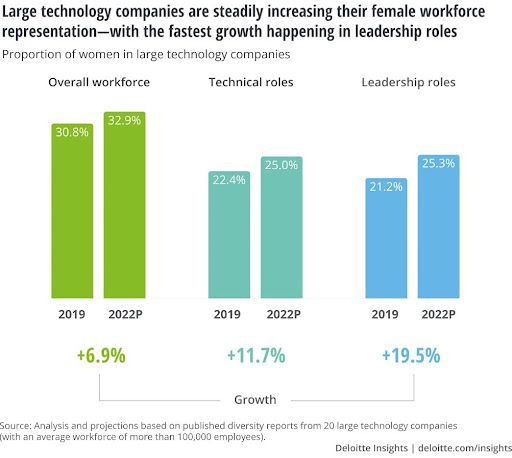28.8%
That’s the total percentage of women working in the technology industry back in 2020, according to this report. This report suggests that the percentage is projected to reach 33% in 2022.
That's just 4.2% growth in 2 years!
The SaaS industry is projected to grow from USD 130.69 billion in 2021 to USD 716.52 billion in 2028 at a CAGR of 27.5%. Now, let's compare the two growth numbers.
4.2% v/s 27.5%
The growth potential is immense.
But a lot needs to be addressed before we can make significant progress. The SaaS industry will be missing out on growth opportunities by not addressing this disparity. Studies have been conducted about declining women's workforce participation in technology.

But are people aware and consciously taking steps to make amends? Let’s begin with this quote by Sheryl Sandberg, COO of Meta (Facebook):
"We cannot change what we are not aware of, and once we are aware, we cannot help but change".
This article is a small effort to bring about that change. Our main talking points include:
- The history of women in technology
- 3 benefits women can bring to SaaS
- 5 steps to including women in the SaaS workforce
A brief history of women in technology
Did you know that a group of six women were the first to program a computer? If not, you should read about ENIAC (Electrical Numerical Integrator and Computer). This is the first electrical computer, and it was programmed during World War II on behalf of the United States Military.
It was used to calculate ballistic trajectories that were otherwise time-consuming and complicated. The group of 6 women programmed the ENIAC and were the world's first coders.
How cool is that!
The code they wrote during the war resulted in the development of computer storage and it marked the beginning of the programming language.

Source: Mashable
Fun fact:
The groundbreaking work of these women coders went unnoticed for years. The public thought that the women in the above photo were models. But they were the coders responsible for the programming. This, more than anything else, demonstrates how women have always been a part of the technology industry.
Before we discuss how we can increase womens' participation in technology, we must understand the skills they possess to ace the technology game.
3 benefits women can bring to SaaS
Women may be uniquely empathetic
Recent studies suggest that women may be particularly empathetic. This may lead to them being better able to understand people, which can be crucial for coming up with better solutions to customer problems
Empathy also plays an important role in the SaaS industry. Understanding your customers leads to building a clearer customer avatar and helps in solving problems faced by the users.
Women may be great multi-taskers.
A study revealed that women may be uniquely good multitaskers. Working in the SaaS industry involves working in various departments like marketing, business development, product development, and customer success.
Not only does this require a lot of skills, patience, and experience, but it also needs quick and prompt action. No doubt, if you’re a great multi-tasker you may be just right for the SaaS industry.
Women bring diversity to the team
There is no doubt that the technology industry is dominated by men. They are in the majority and make up about 72% of the total technology workforce. Although the foundations of the technology industry were laid by women (read: ENIAC), the industry is today led by men.
The technology industry has now diversified into artificial intelligence (AI), cloud computing, machine learning, and data analytics. Women would bring skills to the table that would help the industry with a fresh perspective.
This can not only help increase the overall productivity but also elevate the skills each team possesses. Though we are convinced that women can help grow the SaaS industry, we need to be cognizant that a lot of external factors affect their participation.

A recent article by Harvard Business Review reported that 81% of women of color in the technology industry experienced racism and 90% experienced sexism. One study also found that only 3% of black women want to return to full-time on-site work, post the Covid pandemic (2020), as opposed to 21% of white women.
The study also reported that African-American, Asian-American, and Latino tech workers preferred hybrid or remote work more than their white counterparts. Such studies reveal factors that lead to women having a tough time building presence in the technology industry.
Now that we understand the factors dampening women's participation in the technology industry, we need to understand what steps we can take to include more women in the SaaS workforce.
5 steps to including women in the SaaS workforce
1. Company Culture and Values:
The foundation of company culture and values should be built in such a fashion that it enables women to be great contributors to the team.
For example, in our recent report ("Ones to watch in 2021") we interviewed Sara Rosso (Director of Growth and Product Marketing at Hubspot). Sara helped the WordPress VIP team grow 10 times by establishing critical business and operational processes and leading digital communication, product marketing, and education.
This would have only been possible because the company culture enabled Sara to perform in her role. The company DNA is a great enabler and sets the tone for how the workforce performs while working together.
2. Flexible Working:
With the advent of remote working post-Covid, companies need to support and encourage flexible working. This would enable women, irrespective of their ethnicity, background, or nationality, to work for the SaaS industry.
3. Committing to a diversity, equity, and inclusion (DEI) strategy:
A recent study revealed that professionals are 5.4 times more likely stay with a company for a long time if it has strong DEI policies. Many large technology companies release annual diversity reports to showcase their best practices as a result.
4. Embrace goal-setting, transparency, and accountability:
Technology companies must set goals, be transparent, and be accountable. This would help them track, measure, and improvise. For example, Amazon measures performance ratings and attritions across teams to address any demographic differences.
5. Establish programs to hire, retain, and promote:
If we want more women in leadership roles, we need to hire, retain, and promote more female employees. This requires strong, proactive efforts by technology companies. But how?
One particular strategy could be to hire women talent without any technical background and commit to upskilling them with training programs and mentorships.
SaaS companies could invest in a program that trains and upskills women who are ready to join the workplace after a career gap. Mentorship and development programs offered by women in leadership roles could help a lot of women professionals.
On a brighter note, according to a recent report by Deloitte, roughly one in four leadership positions at large global technology firms are expected to be held by women in 2022.

Source: Deloitte Insights
The SaaS industry and technology industry as a whole has immense growth opportunities and women should be included to lead the growth from the front. Companies should consider widening their professional talent pool by including more women from diverse backgrounds.
The ENIAC example is a great example to learn from.
Women in SaaS have the potential to push the boundaries of excellence to further heights. These are heights the entire technology industry should aim to strive for, as we look to a more inclusive, diverse future.
Psst.. enjoyed this article? The Women in SaaS summit is coming your way in July. Register your interest right here.


